�
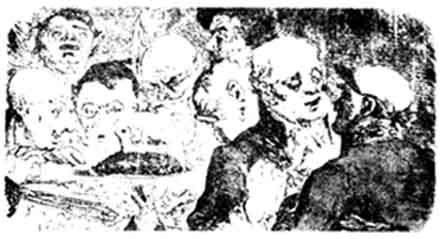
Faked Fossils of Primitive Man
Archeological Fakes 1970
Adolf Reith Trans. by Diana Imber v
[34] Prehistorians and particularly museum experts have to be on the watch for forgeries, which sometimes appear in unexpected areas such as anthropology. At the time of Darwin and Haeckel, that is the latter part of the nineteenth century, the origins of man were passionately discussed by anthropologists and students of Prehistory. Two hundred years earlier it was still very dangerous to talk of fossilized man, or pre-Adam man as he-was then called. The French scholar Isaac de la Peyrere, who supported this view, was only able to save himself from the Inquisition by adopting the catholic faith. At the beginning of the nineteenth century another French scholar, Cuvier, had denied the existence of fossilman until a few decades later (about 1843) a customs official produced evidence. This man, Boucher de Perthes. like John Frere and MacErny in England had found flints, in other words man-made tools. together with the bones of extinct animals. proving that the animals must have lived at the same time as the tool-makers. Hence fossil-man must have existed. The only difficulty was to find his bones and Boucher de Perthes was very keen to do so. His professional colleagues and opponents always asked why he produced as evidence only the tools and never a part even of the skeleton of his antediluvian man, and for decades Boucher could not answer this question. Finally he offered a reward of two hundred gold francs to the first one of his workmen to bring him a bone of antediluvian man. Boucher de Perthes was by now seventy-five. Therefore he was all the more overjoyed when in March 1863. a worker in the gravelpit at Moulin-Quignon (near Abbeville) discovered another five flints (Pl. 11) and with them a human tooth. That seemed conclusive at last and Boucher de Perthes hurried down to the quarry to find, in the same place. another flint. and a little later, five metres below the surface. the lower jaw of a man. He sent the lower jaw to the "Academy of Science" and the anthropologist Jean-Louis Armand de Quatrefages declared the piece not only genuine but [35] of considerable importance (Pl. 12). Then doubts were raised and began to pour in from every side. A group of English and French scholars, one of whom was the famous archaeologist John Evan, declared that the flint tools, as well as the lower jaw, were false. Evans sent an English excavator to Moulin-Quignon-at the time excavators and scholars were distinct-to dig on the site with Boucher de Perthes. But since the Frenchman spoke no English and the Englishman no French such communication as there was led nowhere. Meanwhile the lower jaw was analysed by a chemist who declared that there was a large quantity of organic matter in the bone which must therefore be quite modern. The elderly Boucher de Perthes defended his "lower jaw" with as much obstinacy as subjectivity against the English and closed his dissertation with these words: "Gentlemen, man's intellect can lead him far astray. Now prehistoric man has not only political but also ecclesiastical England against him." Boucher de Perthes clung with the obstinacy of old age to the genuineness of the lower jaw and he continued to defend it against all comers. He died four years later, in 1868, still convinced that the find his workers had produced for him in order to claim the reward was genuine. It was unfortunate that he was not alive to hear the oration delivered at the unveiling of his memorial. when one of the speakers described the lower jaw of Moulin-Quignon as one of the finest jewels in the crown of such discoveries!
The news of Boucher de Perthes's discoveries had scarcely reached the
States when, in 1838, an American called Koch found in Missouri obsidian
arrow-heads lying with the bones of a mastodon, but these were proved to
be modern and had clearly been added later by Mr Koch. It was surely not
chance that barely thirty years later in 1866 led to the discovery of a
human skull in a Californian gold mine about forty yards deep in the tertiary
layer? This "primeval" discovery put the Americans far ahead of
Europe. An anthropologist called Wilson was absolutely convinced that this
was the oldest man in the world, tertiary man, discovered in the gold-laden
sand of Calaveras County in California. Lack of proper means of comparison
made such statements feasible at the time. How the skull came to be lying
so deep was never explained. It is, however, certain that it is identical
with the skull of a modern Californian Indian. This was proved not only
by the remains of a modern snake found within the skull, but by a later
test which gave a negative fluorine
�
[37]
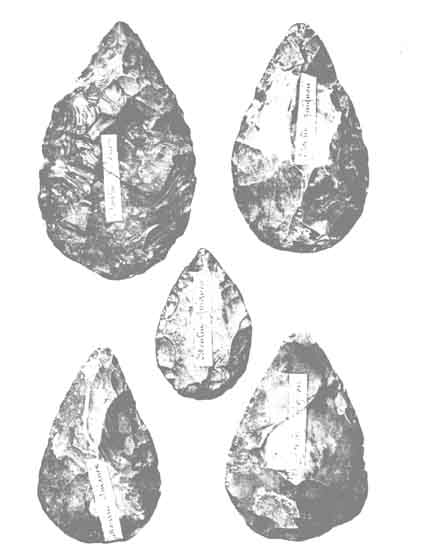
11. Forged flint hand axes, Moulin-Quignon
reaction. Bret Hart wrote a satire about the Calaveras tertiary
man in which he allows the skull to explain how it had belonged to a gold
digger called Bowers, who would much prefer to have been buried in his homeland
of Missouri than to lie forgotten in the drawer of a museum. His wish was
not fulfilled, for today the skull is stored away in the Peabody Museum
in Harvard. (It has since been established that the New World can provide
no Middle Palaeolithic human remains, that is, nothing pre-Neanderthal,
or Neanderthal. Late Palaeolithic man reached and crossed the North American
continent, from the Bering Straits, towards the end of the last great glaciation,
at the earliest, therefore, about 15,000 BC.)
�

12. Discussion over the Lower Jaw of Moulin-Quignon.
Neanderthal man had, however, as our readers are probably aware, already been discovered in Europe when Boucher de Perthes found his lower jaw. The famous discovery at Neanderthal close to Düsseldorf, attributed by its finder, Carl Fuhlrott, to the diluvial period, took place in 1856. Its real age was nevertheless questioned and discussed for many years. Most specialists disagreed with an Ice-age attribution while the well-known anatomist, Rudolf Virchow, described the cranium as a modern pathological deviation, and possibly an individual who had suffered from rachitis and arthritis. Another specialist simplified it even more, attributing the remains to a Russian Cossack who had died there in 1814. Charles Darwin's countrymen, King and Lyell, first recognized the real significance of the discovery and [38] King christened the skull Homo Neanderthalensis in 1864. It was not until 1897 that Gustav Schwalbe first recognized the real importance of this discovery of primitive man. which perhaps dated back as far as the beginning of the second Ice Age. We know now that human bones that have lain for about 80,000 years in the ground undergo great structural changes: that they contain almost no organic material and may be completely calcified. They are dark in colour due to the presence of manganese and are considerably heavier. Apart from these visible signs of great age a chemical method of establishing relative age has been discovered, the so-called fluorine test. The higher the fluorine content, the older the piece of bone. But at the beginning of the twentieth century man had not progressed so far. Subsequently many more excavations were undertaken and research into the history of primitive man produced one find after another: in 1891 a Dutch doctor called Dubois found in the volcanic sediments of Java an extremely primitive skull and a tibia of the much disputed Pithecanthropus Erectus.. In 1907 at Mauer south of Heidelberg was found the still unmatched Heidelberg lower jaw lying embedded with elephant and rhinoceros bones, twenty-four metres deep in the early diluvial layers of the original river Neckar. Between 1908 and 1911 discoveries of Neanderthal man were also made in Dordogne: first the old man of La Chapelle aux Saints. a real burial with flints and rhinoceros bones, followed by the young man of Le Moustier, also a grave with its contents, and finally at La Ferrassie a complete graveyard with a man and a woman and four children.
In 1908, that is at the time when research into primitive man was at its peak in France another primitive skull was found in a place that had already been mooted, Piltdown near Brighton in southern England. In 1908 the solicitor Charles Dawson, keen amateur geologist and collector, dug out of this gravel-pit a fragment of a human skull having the appearance of a fossil. Three years later other pieces were found. apparently from the same skull, and finally in 1912 Smith Woodward, the well-known English anthropologist, found a part of the lower jaw with two molars, although unfortunately the end of the joint was broken (Pl. 13a). The next year, 1913, saw the discovery by Teilhard de Chardin of another single human canine tooth and the same year Dawson found two nasal bones. The time table of the finds is as follows:
| YEAR | OBJECT | FINDER |
| 1908 | Left cranial bone | Dawson |
| 1911 | Part of the forehead and back skull | Dawson |
| 1912 | Back of skull, right lower jaw (half) | Smith Woodward |
| 1913 | Two nasal bones and a canine | Dawson |
| 1915 | Fragments of skull and molar (1-1/2 miles from site) |
Dawson Teilhard de Chardin |
The next problem was to dispel the impression that these pieces had all been swept together into one place and were no longer therefore in their original position. Also it proved difficult to fit the pieces together because of the broken edges (P1. 14). Having got so far someone realized that the cranium was 10-12mm thick (it is usually about 5-8 mm) and that the forehead lacked the Neanderthal eyebrow swellings. The region of the eye on the Piltdown skull scarcely differed from Homo Sapiens, whereas the lower jaw was much more primitive in comparison, giving an altogether ape-like appearance in contrast to the astonishingly highly developed cranium. It differed from the most primitive human jaw and was much more like that of ape-man, which had already been fully described in 1913. Despite all objections, however, the finder and the scholar-Mr Dawson and Mr Smith Woodward-stuck to their claim that all the fragments of the skull belonged to one individual. Indeed it would have been an unlikely coincidence for the upper cranium of a hitherto unknown primitive man to be found beside the fossilized lower jaw of a hitherto unknown ape-man.
In 1912 the English scientists published their conclusions on the Piltdown
finds. This epoch-making event was reported by the Manchester Guardian
in the following stirring words: "The lecture hall of the Geological
Society was filled as it has never been before." Dawson himself reported
about the actual discovery of Piltdown, expertly and modestly. He dated
the gravel-pits of Piltdown to the early Ice Age and supported this chronology
with fragments of elephant and hippopotamus teeth and with ancient flint
tools. all with acceptable pre-Chellean characteristics. He suggested 500,000
years as the very youngest for the remains of the skull. Smith Woodward
of the Natural History Museum (British Museum) followed Dawson's report
with his own remarks. Smith Woodward believed in the finds from the first
and
�
[41]
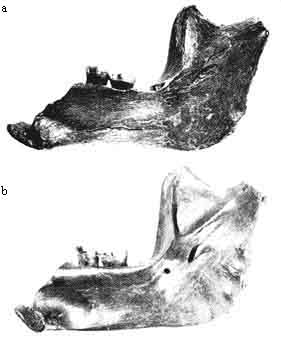
13. a Lower jaw of Piltdown man, patinated and the teeth filed (Orangutang); b. Lower jaw of a female Orangutang.
even went so far as to prophesy before its actual discovery what
the canine tooth must be like, larger than in man, but not so long and protruding
as in the anthropoid apes. "This unique fossil," he concluded,
"combines an ape-like lower jaw with a human cranium and deserves a
special place in the zoological system. Therefore we suggest that this skull
is evidence of a new type and kind of man, to be called. in honour of its
finder, Eoanthropus Dawsoni, in German, Dawson's Morgenrothemensch-('Dawson's
Dawn Man')", to which the Manchester Guardian added: "Piltdown
man is incontrovertible evidence of the ape-origins of man. This must clearly
be the oldest, the first Englishman."
�
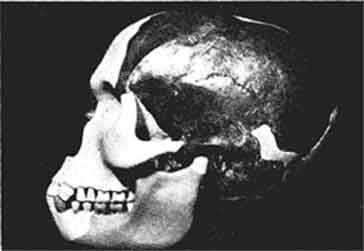
14. The Piltdown skull. Combination of man and Orangutang.
During the summer of 1913 that followed this session, the young Teilhard
de Chardin, a Jesuit, found the human canine, once again in a fall of gravel
in the Piltdown quarry. Two years later, a mile and a half away, Dawson
made the last discovery: [42] another individual of the type Eoanthropus.
The First World War broke out at the same time, taking precedence in the
news, but suspicions about the English "Dawn Man" were
by no means stilled. Since about thirty per cent of the whole cranium was
available, new combinations and reconstructions of the bones were always
being tried. Two portraits reveal the depth of interest; one is unshaven,
ape-like and yet decadent in a human way, while the other is more modern
and more English in appearance (P1. 15). The priceless original pieces were
held by the Museum of Natural History in London and shown only rarely to
specialists, who were never allowed to touch the fragments. The result,
though probably unintentional, was that a close study of the lower jaw was
prevented.
�
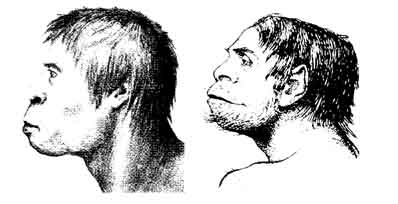
15. Reconstructed portraits of Piltdown man.
Nevertheless throughout the twenties and thirties the doubts multiplied. The anthropologists Boule (Paris), Mollison (Munich) and Hrdlicka (Washington) all agreed that the Piltdown lower jaw could not possibly belong to the cranium and in 1938 the Tübingen anthropologist, Gieseler, wrote: "It seems to me likely that the lower jaw found at Piltdown has nothing to do with the skull . . ." and further on, even more definitely: "The fragments
[43]
�
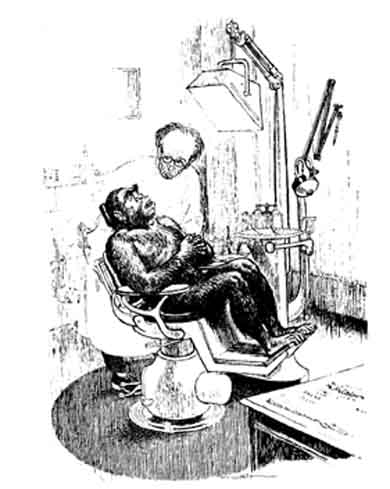
16. Dawn Man at the dentist. "I am sorry I shall have to extract the whole of the lower jaw."
[44] of skull all belong together and are human, the lower jaw, on the contrary, resembles an anthropoid ape (P1. 13a). Therefore Eoanthropus collapses and particularly because it is impossible to estimate the age exactly." The Frankfurt anthropologist Weidenreich, expressed the same views when he wrote in 1943: "The sooner the chimera known as Eoanthropus is eliminated from the list of human fossils the better for science." Another German scientist, however, H. Weinert, who had written a series of books on primitive man, defended Eoanthropus to the last. He noted in 1932, perhaps rather too spiritedly: "Nature has here played one of her ironical tricks. Finds of ape-men fossils are rare. Science can never get enough, but here in Piltdown we found too much. It would have been better for our diagnosis and our genealogical hypothesis if there had been less." But after this slightly ironic start he continues perfectly seriously: "However the Eoanthropus problem may be solved it does not alter the fact that this undoubtedly phylogenetically important piece give the impression of a chimpanzee." In other words Eoanthropus despite all contrary opinions seemed to fit into Weinert's genealogical scheme and therefore was retained by him. Fifteen years later, after the Second World War, Weinert still believed that the cranium and lower jaw of Piltdown man belonged together, though now the combination seemed to him more like the skull of a prehistoric Tasmanian. And the first edition of his book of the Primitive History of Man published in 1952 still contained the following words: "The lower jaw of Piltdown man is not really so ape-like. It could be the jaw of a homo sapiens of similar type."
Meanwhile. however, two English anthropologists, Hopkins and Oakley, had quietly taken up the case of Piltdown again, avoiding public discussion but following proper scientific methods. They subjected the skull to the fluorine test which depends on the fact that the element fluorine which is present only in minute quantities in water, combines with phosphoric calcium in the bones, so that the fluorine content increases with the length of time a piece of bone is subjected to the damp conditions of burial. Hence the greater the fluorine content the older the bone. Unfortunately there was not enough material to work on for the first analysis, for of course parts of the first Englishman had to be dispensed with circumspection. Nevertheless the amount of fluoride proved to be so small that an age of 100,000 years could scarcely be supported by the evidence. A second analysis was [45] done in 1953 with a larger piece of bone. The surprising result of 0.03 per cent fluorine in the lower jaw was about the amount to be expected from a modern anthropoid ape. The result of the analysis was as follows:
Lower Jaw: Fluorine, traces present; nitrogen, very high; carbon, high; water, high; gelatine, present; calcium, absent; iron, also present on the surface.
Skull: Fluorine, traces present; nitrogen, low; carbon, low; water, low; gelatine, nil; calcium, present; iron, also present.
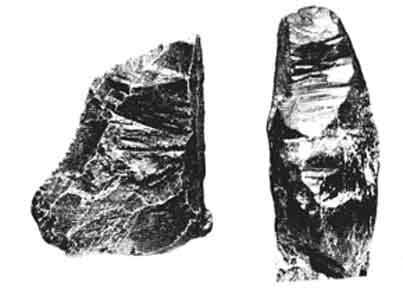
17. Tools of Piltdown man: left new; right false, made of old ivory, both made with a knife.
The bone of the lower jaw was so recent that the drill used for taking samples produced a smell of burning horn. The lower jaw therefore belonged, not to the first Englishman, but to a recent [46] orang-utang. (Pl. 13b). This rejuvenation was caricatured in Punch with a scene in the dentist's chair, in which the surgeon was explaining to the trembling Mr. Piltdown: "It will probably hurt, but I'm afraid I've got to extract the whole lower jaw" (Pl. 16).
Oakley also proved that the lower jaw had been intentionally broken and coloured brown, aged, in fact, with Potassium-bichromate. The colour, however, remained only on the surface, as was also the case of the incisor discovered by Teilhard de Chardin, which had a nice patination of Van Dyck brown. The molar embedded in the lower jaw had been filed to make it appear more human and this had been carried so far, that the forger had filled the open socket with grains of sand. Now that the lower jaw had proved to be an orang-type ape, all the tools and animal bones found with it were subjected to more critical examination. Remarkably the flint tools also exhibited an artificial iron patina, and a piece of bone forty centimetres long that had been presumed to be part of a fossilized elephant's tibia, revealed traces at one end of modern tool work-cuts, in fact, that could only have been made by a metal blade (Pl. 17). Also it was shown that the accompanying animals, consisting of genuine remains of the teeth of pre-Ice Age elephants and hippopotamuses from other sites had also been coloured with Potassium-bichromate.
But what of the cranium? According to its fluorine content (0.1 per cent) an age of a few thousand years was at least feasible. Whence it came, or what man it had been no one knows (it is not necessarily even an early Englishman, but might also be a continental Celt). Thus, strangely, the affair of the oldest human fossil of the British Empire was closed.
Who then was the practical joker? Who assembled Dawn Man and his Culture? He must have had considerable knowledge of anthropology, geology and palaeontology, for by planting genuine mammal's teeth into the hitherto undated gravel he created an antediluvial layer, well aware that the English geologists had long sought such a deposit in southern England. Into this false setting the trickster laid a combination of human and ape-bones, intending to form an ape-man with a very highly developed forehead. but a much more primitive lower jaw, an early man. but one whom the implanted tools would indicate to be truly human.
The faker could not be a scientist of the standing of Dr Smith Woodward,
who must be entirely ruled out. (He died in 1947 still [47] firmly believing
in Piltdown man.) Suspicion automatically fell on Dawson (he died in 1916,
but in 1938 a memorial had been raised on the site of the discovery of Dawn
Man). Besides which, shortly before the fraud was discovered, the government
had declared the famous gravel-bit to be a National Monument. A further
excavation undertaken by scientists after the war produced, of course, nothing.
�
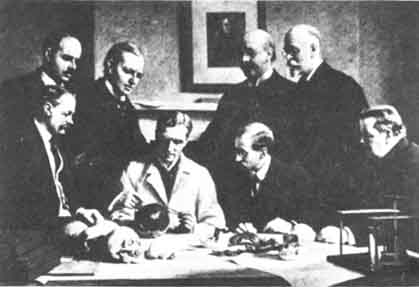
18. Discussion over the Piltdown skull: standing in front of the portrait of Darwin, Charles Dawson.
Who was Charles Dawson? He is depicted in an oil-painting among several authoritative experts of English natural science exuding dignity and responsibility, a Victorian gentleman of the old school from heed to toe (Pl. 18). For a layman he had [48] remarkable geological knowledge. Nevertheless he was probably always conscious of his amateur status when in company with experts. This explains the fact that he was continually drawing attention to himself by making extraordinary public announcements. Once he said he had seen a sea serpent in the Channel. Then he discovered a petrified toad, but it proved to be a trick of nature. Besides this he also devoted himself to the history of iron-smelting and published a cast-iron Roman statuette, though it was a fake which had probably deceived him too. (For all the evidence points to the Middle Ages as the earliest date for cast-iron in Europe.) Dawson's greatest scientific passion was really to try to find "missing links", not only in the zoological but also the ethnographical field. For instance, he found a tooth that seemed to be a stage between reptile and mammal. He tried to cross goldfish and carp in order to produce the golden carp. He announced the discovery of a kind of boat, half coracle. hall canoe . . . so why should he not discover a new "missing link" between man and the apes, as Dubois had discovered Java man (Pithecanthropus) and why go to foreign parts to do it, when England was full of gravel-pits?
Dawson possessed both the experience and the imagination to carry out the very bad joke, which in fact kept the whole archaeological world occupied for decades (about three hundred different theses were produced on Piltdown man). When the suspect is dead however it is no longer possible to convict for fraud. But who, besides Dawson. could have worked out and carried through such a plan? Some have tried to show him to have been the victim of a forger, whose traps he had fallen into for eight years, and who was always preparing new ones in which Dawson was promptly ensnared. But this is too artificial an excuse to ring true, and Dawson is known to have hardened bones with Potassium-bichromate. Recently it has also been discovered that he was a friend of the notorious Bristow of exotic bird fame (see page 31). It all points to Dawson as the only person who could have executed a deception of this kind in all its aspects.
Weinert's book on the "Piltdown Affair" seemed to close the
matter, when in 1962 a book by Sanderson on the Abominable Snowman brought
it into the limelight again. This writer. on page 62 of his book' speaks
of the "notorious Piltdown skull" which "a rather questionable
collector called Dawson had augmented [49] with fake bone tools".
Later, however, on page 365, he attributed the skull, but without any evidence,
to an age of 50,000 years and finally is so bold as to suggest that Dawson
had found the fragments in East Anglia and had subsequently planted them
at Piltdown in the secondary layer to have an excuse to bring them once
again before the public eye. Piltdown still haunts a good many even today.
�